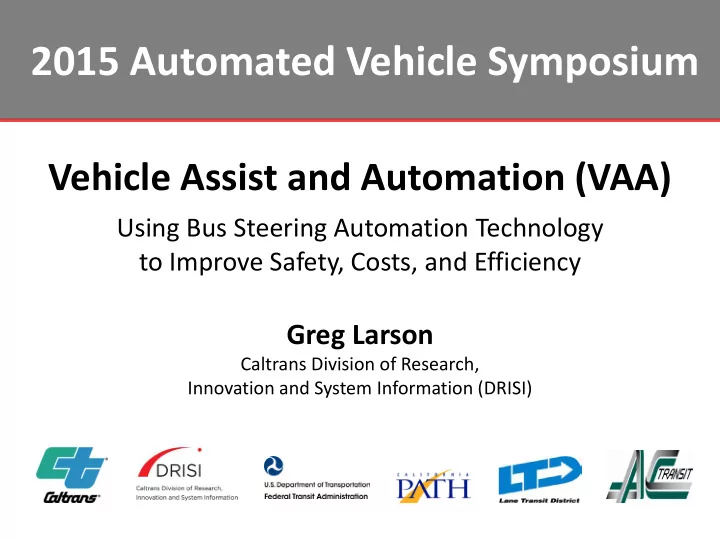

2015 Automated Vehicle Symposium Vehicle Assist and Automation (VAA) Using Bus Steering Automation Technology to Improve Safety, Costs, and Efficiency Greg Larson Caltrans Division of Research, Innovation and System Information (DRISI)
Levels of Automation
Bus Rapid Transit Issues Today Customers demand high-quality transit services Agencies need a safer and more cost-effective transit system Insufficient funding for building and operating new light or heavy rail systems Space limitations for installing bus-only lanes in existing ROW Drivers complain about driving in narrow, bus-only lanes
How Does VAA Help? Potential Benefits: • Reduced right-of-way requirements and infrastructure build-out costs • “Rail-like” operations • Smoother and faster travel • Reduced operating and maintenance costs • Reduced accidents
VAA: An Enabler for BRT Feasible Level of Investment Region (e.g. Capital Cost, Operating Heavy Cost) Rail LRT BRT with VAA • Fully Grade Separated • Roadway Shoulder Operations • At-Grade Transit- way BRT • Designated Arterial • Urban Circulator • Suburban Collector Bus Los Angeles Metro Rapid Los Angeles Local Bus Level of Service/Performance Measure (e.g. Capacity, Operating Speed, Travel Time, etc.) 5
US DOT VAA Program The U.S. Department of Transportation, through the Federal Transit Administration (FTA) and the ITS Joint Program Office, awarded three cooperative agreements to demonstrate, in revenue service, one or more Vehicle Assist and Automation (VAA) applications for bus-based, full-size public transit vehicles.
Vehicle Assist and Automation (VAA) is… a technology that guides buses using magnets, just as trains are guided by tracks.
Magnetic Marker System Superior performance -- • Support tight lane guidance and precision docking Robust -- Operable with all • weather and road surface conditions Safety -- Can detect missing • magnets Low costs -- infrastructure • installation: ~$20-30k per mile for magnets installation Maintenance free for • infrastructure
Automated BRT Demonstrations Automated Bus Demonstration at APTA 2003 in San Diego Demonstration of Lane Guidance and Precision Docking Systems at 2005 ITS World Congress in San Francisco
Automated BRT Demonstration Field tests & demonstration of lane guidance system along AC Transit’s East 14 th Street BRT route in San Leandro • First time testing and demonstration of the magnetic guidance in a real world urban setting • System demonstrated its repeatability and reliability under real-world conditions (with street crowns and obstacles, mixed with city traffic) • Lessons learned here benefited later VAA development • Workshop with California transit agencies received positive response
Automated BRT Demonstration
Caltrans VAA Project Objective: Demonstrate the technical feasibility of lateral vehicle guidance and how vehicle guidance can improve transit agency operational efficiency, performance and service quality Partners: • LTD – Eugene, Oregon • AC Transit – Alameda County, California • UC Berkeley PATH Program • FTA – Federal Transit Administration
LTD VAA Overview 23 mile BRT line • 3 miles of magnets installed LTD maintenance yard test track One 60’ New Flyer bus equipped • Two sensor bars • Steering actuator • Computer controller • Human-Machine Interface display
LTD Automated Bus (New Flyer 60’) Automated System Installation/Configuration J1939 connection Actuator Buzzer (2) HMI controller (2) Instrument Cabinet Control computer (2) controller (25x15x38) cm Indicators (2 sets) Switch & button GPS Yaw rate gyro Front & rear magnetometer sensor bars (2) Steering actuator Magnetometer sensor boards
A Large Step Towards Deployment • Substantial new hardware and software developments that better integrate with different transit buses and improve reliability and safety • Product-like components and subsystems • Safety – Fault Detection and Handling • Infrastructure preparation: design and installation • Close collaboration with transit agencies and drivers • Real-world operating scenarios • Real-time data collection and independent evaluation • Operation in revenue service!
Can Transit Agencies be Early Adopters of Vehicle Automation? There are compelling reasons for initially focusing on heavy vehicles, such as buses, trucks, and agency maintenance vehicles: Trained, professional drivers that are more likely to be able to re-take control, if needed Well-maintained vehicles that are less likely to have failures in the first place Costs for added automation equipment are incrementally low compared to the overall cost of the vehicle Easier to add equipment, since internal data networks are based on open standards (SAE J1939) Some vehicles operate on exclusive right-of-way, which minimizes interference from human-driven vehicles Fleet Operators are open to trying new practices that reduce business costs
Questions and Discussion Caltrans Division of Research, Innovation and System Information http://www.dot.ca.gov/hq/drisi/ Caltrans provides a safe, sustainable, integrated and efficient transportation system to enhance California’s economy and livability
Recommend
More recommend